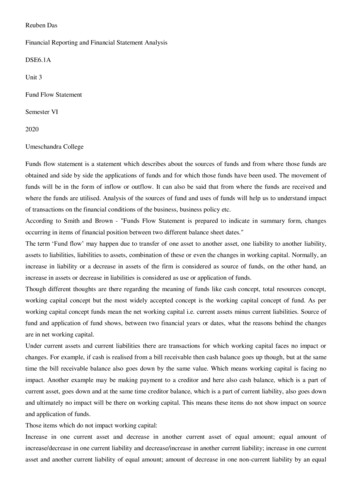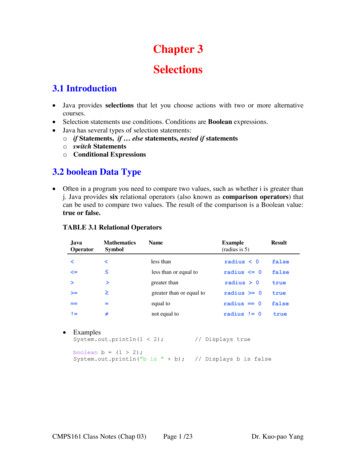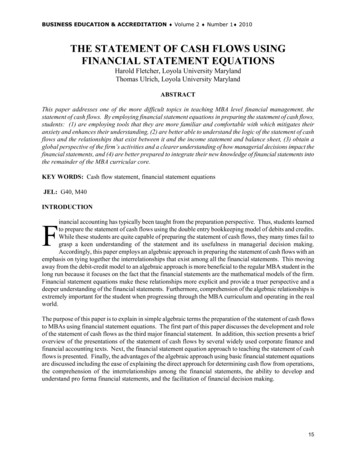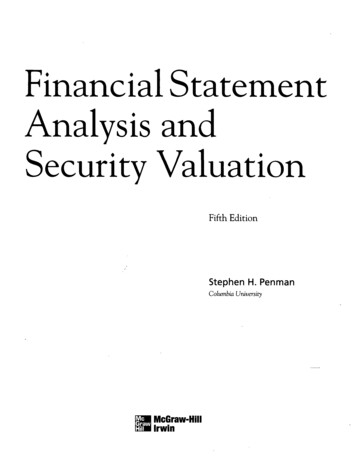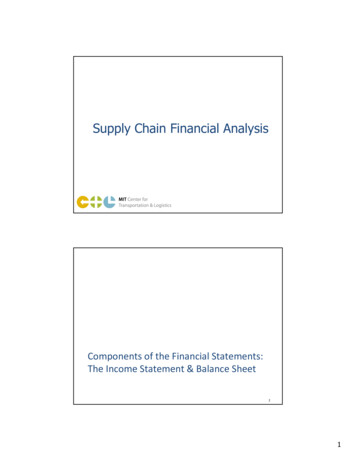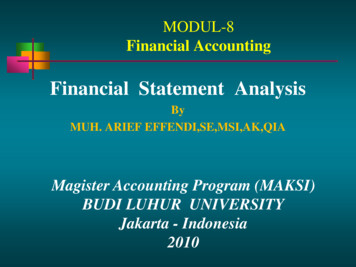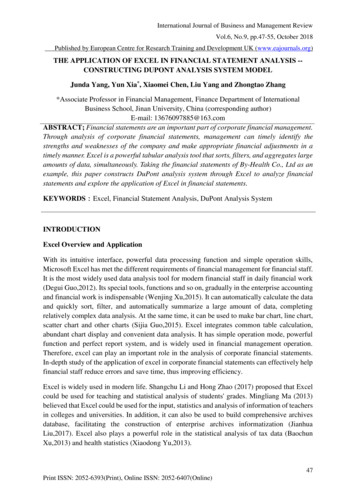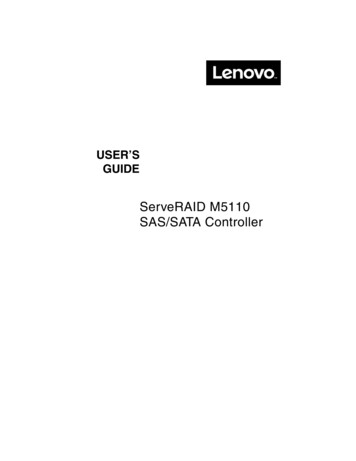
Transcription
IRA-International Journal of Management &Social SciencesISSN 2455-2267; Vol.05, Issue 01 (2016)Pg. no. 1-9Institute of Research MSSFinancial Statement Analysis of AshokLeyland Limited, India1Harshadeep ChilukuriFinal Year MBA StudentRVS Institute of Management Studies and ResearchSulur, Tamilnadu-641402, India.2Stephy Thankam VargheseFinal Year MBA StudentRVS Institute of Management Studies and ResearchSulur, Tamilnadu-641402, India.Type of Review: Peer Reviewed.DOI: http://dx.doi.org/10.21013/jmss.v5.n1.p1How to cite this paper:Chilukuri, H., & Varghese, S. (2016). Financial Statement Analysis of Ashok LeylandLimited, India. IRA-International Journal of Management & Social Sciences (ISSN2455-2267), 5(1), 1-9. doi:http://dx.doi.org/10.21013/jmss.v5.n1.p1 Institute of Research AdvancesThis work is licensed under a Creative Commons Attribution-Non Commercial 4.0International License subject to proper citation to the publication source of the work.Disclaimer: The scholarly papers as reviewed and published by the Institute of ResearchAdvances (IRA) are the views and opinions of their respective authors and are not theviews or opinions of the IRA. The IRA disclaims of any harm or loss caused due to thepublished content to any party.1
IRA-International Journal of Management & Social SciencesIntroduction:The Indian auto industry is one of the largest in the world. The industry accounts for7.1 per cent of the country's Gross Domestic Product (GDP). As of Financial Year 20142015, around 31 per cent of small cars sold globally were manufactured in India. The TwoWheelers segment with 81 per cent market share is the leader of the Indian Automobilemarket owing to a growing middle class and a young population.Moreover, the growing interest of the companies in exploring the rural marketsfurther aided the growth of the sector. India is also a prominent auto exporter and has strongexport growth expectations for the near future. In April-January 2016, exports of CommercialVehicles registered a growth of 18.36 per cent over April-January 2015. In addition, severalinitiatives by the Government of India and the major automobile players in the Indian marketwere expected to make India a leader in the Two Wheeler (2W) and Four Wheeler (4W) marketin the world by 2020.India’s second largest commercial vehicle maker Ashok Leyland has shown adeclining trend in the total sales during August 2016 by 6 per cent due to lower growth inMedium and Heavy Vehicle segment. The company sold ten thousand eight hundred andninety-seven (10,897) vehicles in the month gone by, compared with 11,544 units sold in thesame month last year. Medium & Heavy commercial vehicle sales during the month declined8 percent to 8201 units while light commercial vehicle sales grew by 2 percent to 2696 unitson yearly basis. The contribution of Ashok Leyland in the growth of the automobile industryis very high. Hence an attempt is made to analyse the financial statement of Ashok Leyland.Statement of the ProblemThe role of financial reporting by companies is to provide information about theirperformance, financial position and changes in the financial position that is useful to a wide rangeof users in making economic decisions. The role of financial statement analysis is to take financialreports prepared by companies, combined with other information, to evaluate the past, current andprospective performance and financial position of a company for the purpose of makinginvestment, credit and other economic decisions. As several initiatives is taken by the governmentof India towards automobile industry major automobile players are expected to make India asleader in Commercial vehicles. As Ashok Leyland is one the major player in the Automobileindustry in India, conducting financial statement analysis for Ashok Leyland Limited is foundimportance at this juncture.Objective of the StudyThe following were the objectives framed by the researcher to analyze the financial statementof Ashok Leyland: To analyze the Working Capital Position of Ashok Leyland.To study the Cash position of Ashok LeylandTo find out the Profitability Position of Ashok LeylandTo measure the Returns of Ashok Leyland.To study the Efficiency of Ashok Leyland in managing its assetsTo scrutinize the Liquidity position of Ashok Leyland.Period of the StudyA period of five years is taken for the analysis purpose from 2011-2012 to 2015-20162
IRA-International Journal of Management & Social SciencesTools used for analysisThe following tools were used for analysis of financial performance of Ashok LeylandLimited: Ratio Analysis Du-Pont AnalysisWorking Capital Analysis of ASHOK LEYLANDWorking Capital is required to run the day-to-day business activities. It is the amount to befunded for the business operations. Every business firm require working capital, indeed firms differ intheir requirements of the working capital. A firm should maintain a sound working capital position. Itshould have adequate working capital to run its business operations. Both excessive as well asinadequate working capital positions are dangerous from the point of view of a firm. A firm’s workingcapital position is not only important as an index of liquidity but it also used as a measure of thefirm’s risk.Analysis of Working Capital as a Percentage of SalesFactor201220132014(Rs. in lakhs)20152016714,371Non-Cash CurrentAssets427,133428,259540,144596,962Current ing 1(4.43) %(8.09) %(12.40) %(10.16)%Working Capital as apercentage of Sales(12.64) %Inference:Working Capital is the amount that is to be funded for day to day operations of the company. TheWorking Capital Requirement of the firm changes with sales. Here, Working Capital shows negativethat clearly indicates the following two reasons. Current Liabilities are more than the Current Assets. Specifically, negative working capital most often arises when a business generates cash soquickly that it can sell a product to the customer before it has had to pay its bill to the vendor in thelater stage. In the meantime, the vendors fund is effectively used in the business.Working Capital as percentage of sales is negative and it indicates Ashok Leyland companygenerates cash so quickly. Before paying bill to the vendor, Ashok Leyland is effectively using thevendor’s money for rotation in the business for its growth.Cash Analysis of Ashok LeylandCash is the basic input needed to keep the business running on a continuous basis. It is also theultimate output expected to be realised by selling the service or product manufactured by the firm.3
IRA-International Journal of Management & Social SciencesThe firm should maintain a sufficient amount of cash. Cash shortage will disrupt the firm’smanufacturing operations while excessive cash will simply remain idle, without contributing anythingtowards the firm’s profitability. Thus, a major function of the financial manager is to maintain a soundcash position.1. Days of Funding in different Components(Rs. In lakhs)Ratio20122013201420152016Inventory TurnoverRatio5.86.67.49.810.0Receivables TurnoverRatio10.58.88.311.313.6Payables TurnoverRatio5.05.04.45.07.0Inventory Days6355493736Receivables Days3542443227Payables Days7373827352Average InventoryPeriod48 daysAverage CollectionPeriod36 daysAverage PaymentPeriod71 daysInference:On an average Ashok Leyland requires 48 days to recover the amount stuck as inventory, 36days to receive the amount out of credit sales from the debtors and 71 days to pay the amount forpurchases to the suppliers. The average payment period is more than the average collection period;hence the company is effectively utilizing the suppliers fund in the business for rotation.2. Cash Conversion Cycle2012201320142015(In days)2016Inventory Days6355493736Receivables Days3542443227Payables Days7373827352Cash ConversionsDays252411(4)114
IRA-International Journal of Management & Social SciencesInference:Cash Conversion Cycle tells about the number of days the Company has to fund the business forsmooth operations. From the above analysis it is evident that Ashok Leyland requires on an averagefor 13 days’ funds to be supplied for the business on account of inventory, receivables and payables asthe average cash conversion cycle for Ashok Leyland is 13 days.3. Cash Flow Statement Analysis2012201320142015Cash from OperatingActivities114,73172,830(10,400)49,561Cash from 68)Cash from FinancingActivities24,11241,69846,12938,065Net Cash Flow33,092(1,904)(1,997)75,058(Rs. In sh from Operating activities is on decreasing trend up to 2014, the increase is at a higher rate in theyear 2015 due to increase in the sales and suddenly decreased in the year 2016. Cash from operatingactivities is not going in line with profit after taxes due to working capital mismanagement in thecompany. Cash from investing activities of Ashok Leyland is negative from the year 2012 to 2015 dueto huge amount of capital expenditures made by the company for modernization and expansionactivities. Cash from financing activities of Ashok Leyland is almost shows increasing trend. NetCash Inflow, indicates they are not repaying any loans or they are raising money from differentsources. The net cash flow available in Ashok Leyland for the usage has drastically reduced in theyear 2014 and showing increasing trend from 2015. In the year 2016 the company has raised morefund from outside sources and they have also got some funds by selling assets but the cash inflowfrom operations is negative due to reduction in sales. This indicates that the company has to takeeffective measures to increase the sales in the forthcoming years.Profitability Analysis of Ashok LeylandThe primary objective of a business undertaking is to earn profits. A business needs profitsnot only for its existence but also for expansion and diversification. The investors want an adequatereturn on their investments, workers want higher wages, creditors want higher security for theirinterest and loan and so on. Profits are, thus a useful measure of overall efficiency of a business.(Rs.in Lakhs)RatioEBITDA 2%14.93%10.40%EBIT Margin7.31%4.47%(0.13)%7.34%12.39%14.10%PAT Margin4.39%3.47%(2.02)%(1.39)%5.32%4.92%5
IRA-International Journal of Management & Social SciencesInference:Both EBITDA Margin and EBIT Margin decreases in the year 2014 and from 2015 to 2016 it isshowing increasing trend. The growth rate (CAGR) of EBITDA Margin is 10.4% and EBIT Marginis 14.1%. This shows good sign for the company. PAT margin when compared to EBITA margin isvery less due to the depreciation expenses as the company has spent lot of the amount on fixedassets in the last two years. The company has also increased its short term and long termborrowings in the last two years which increased the interest expenses. Overall the profitability ofthe company has improved in 2015-16 and the profitable position of the company is improvingwhich is good for the company.Analysis of Returns in Ashok LeylandThe profitability and efficiency of the business is measured to find out the return that the firmhas earned by employing capital and assets. This analysis measures the efficiency by comparing thecapital employed and it return at various stages. This analysis is considered to be much important asits gives the percentage of returns earned by employing capital and assets.(Rs.in Lakhs)Ratio20122013201420152016CAGRReturn on equity13.44%9.73%(4.11)%2.97%21.45%12.39%Return on Asset7.92%4.26%(0.09)%5.77%11.15%8.92%Return on Inference:The ROE of the company has declined rapidly in the year 2014, but it has increased in the year2015. From above we can see ROE increased rapidly in the year 2016. This clearly depicts that thereturns available to equity shareholders is improving. Hence the profitability and efficiency of thecompany is improving.The ROA of the company is showing a declined rapidly in the year 2014, but it has increased in theyear 2015. From above we can see ROA increased in the year 2016. This states that the companyhas taken effective steps to use its assets efficiently to improve the earnings of the company.Therefore, ROA shows an improving trend.The ROCE helps the firm in devising the future business policies for the expansion or diversification.ROCE of the company shows a declining trend in the years 2012-2014, but it has increased in the2015, 2016 depicting that the company has extensively planned for the expansion activities.Overall the profitability and efficiency of the firm in increasing, its returns are improving.Leverage Analysis of Ashok LeylandThe long-term solvency of the firms is found using leverage analysis. Solvency refersto the ability of the firm to meet its long term obligations. The long term creditors of a firm areprimarily interested in knowing the firm’s ability to pay regularly interest on long term borrowings,repayment of the principal amount at the maturity and the security of their loans. The leverageanalysis indicates the firm’s ability to meet the fixed interest and costs and repayment schedulesassociated with its long-term borrowings.6
IRA-International Journal of Management & Social Sciences(Rs.in lakhs)Ratio20122013201420152016CAGRInterest CoverageRatio3.71.5(0.02)1.32.6(8.44)%Debt Equity Ratio0.570.791.691.561.7432.18%Debt Asset Ratio0.200.270.390.360.3817.40%Inference:Interest coverage ratio shows that the company is having enough earnings to pay its interest fordebts. The interest coverage position of the company was on a comfortable zone in the years 2012 asthe ratio is above 3. In the years 2013 to 2016 the interest coverage has declined below 3 and thecompany has to be caution in this issue and try to improve its efficiency in using its assets, reducingexpenses and improving profitability to have comfortable earnings to meet its interest expense. In2016, coverage ratio is almost near to 3. This indicates company has taken necessary steps to increasethe interest coverage ratio.Debt Equity ratio reflects the relative claim of creditors and shareholders against the assets of thefirm. As Long term borrowings is more, the company has more Debt to Equity ratio in 2014-2016.The company has to take necessary actions to maintain company in good position.Debt Assets ratio is to determine the financial risk of the business. It is stable in the company whichclearly indicates that the company has effectively used its borrowings to its assets.Efficiency Analysis of Ashok LeylandFunds are invested in various assets in business to make sales and earn profits. The efficiencywith which assets are managed directly affects the volume of sales. The better the management ofassets, the larger is the amount of sales and the profits. Turnover ratios measure the efficiency andeffectiveness with which the firm manages its assets.(Rs. in lakhs)Ratio20122013201420152016CAGRInventory Turnover 3211.3313.636.79%5.025.024.434.986.978.55%Asset Turnover Ratio (%)108957990(4.45)%Fixed Assets TurnoverRatio1.701.421.281.50(3.08)%Receivables TurnoverRatio(Times)Payables TurnoverRatio(Times)660.997
IRA-International Journal of Management & Social SciencesInference:Inventory turnover Ratio is a measure of the number of times inventory is sold or used in a timeperiod such as a year. Here, it’s showing increasing trend (2012-2016). It indicates good sign for thecompany. Here the company Inventory turnover is almost 5-10 times, they keep on replenishing theinventory. Hence the company is efficient in the inventory management.Receivables turnover ratio is an activity ratio, measuring how efficiently a firm uses its assets.Receivables Turnover Ratio of the company started decreasing trend from 2012-2014indicating poor management of receivables. From the year 2015 the ratio increased which clearlydepicts that the company has taken steps to improve the receivables collection and reduce debtors.Payables Turnover ratio has decreased in the 2014 which is good signal for the company. Lower theratio better in managing the payables, higher ratio indicates that the company is delaying the paymentto its suppliers which is not good. Suppliers will not be willing to provide goods to the concerns thatsqueeze them too much by delaying the payment. From the year 2015 the ratio has increased. Thisindicates not good sign for the company in making payments to its suppliers. To be in good position,company has to take necessary steps in bringing payable turnover ratio down.Asset Turnover ratio of the company shows a decreasing trend up to 2014 which indicates that theassets were not properly utilized in the company to the fullest capacity to increase the profitabilityposition of the company. From 2015, the company Asset turnover ratio shows increasing trend. Thisindicates company has taken necessary steps in increasing the Profitability of the company. It’s agood sign for the company.Fixed Assets Turnover ratio of the company shows a decreasing trend up to 2014 which indicatesthat the fixed assets were not properly utilized in the company to the fullest capacity to increase theprofitability position of the company. From 2015, the company Fixed Assets turnover ratio showsincreasing trend. This indicates company has taken necessary steps in utilizing their fixed assets and ithelps in increasing the Profitability of the company. It’s a good sign for the company.Overall, this indicates Ashok Leyland is efficiently managing its assets.Liquidity Analysis of Ashok LeylandLiquidity refers to the ability of a company to meet its current obligations as when thosebecome due.Ratio20122013201420152016(Rs. in lakhs)CAGRCurrent Ratio0.890.810.870.960.992.69%Quick Ratio0.260.270.290.370.389.95%Inference:The Current Ratio reveals the relationship between current assets and current liabilities. This ratio alsoreveals that how efficiently the working capital of the firm is used. If Current Ratio is equal to 2, itindicates that the concern has the ability to meet current obligations. Here the Current Ratio hasdecreased in 2013 and then its showing increasing trend every year. It is a good Sign for the company.Over all, the Current Ratio is less than 2. It indicates that the concern has difficulty in meeting itscurrent obligations.The Quick Ratio reveals the relationship between quick assets (current assets – inventories) andcurrent liabilities. This ratio also reveals the ability of the firm to convert its current assets quicklyinto cash in order to meet its current liabilities. If Quick Ratio is equal to 1, it means that the concernhas the ability to meet its very short term obligations. Here the Quick Ratio showing Increasing trend8
IRA-International Journal of Management & Social Sciencesevery year 2012-2016. It is a good sign for the company. Over all, the Quick Ratio is less than 1. Itindicates that the concern has difficulty in meeting its very short term obligations.Overall the liquidity position of the company is not good.Suggestions1.Reduce InventoryThe average inventory days of Ashok Leyland is forty-eight days which is slightly on a higherside. Hence the company has to take necessary steps to reduce the inventory days by reducing theinventory as lot of working capital is held up in the company has inventory.2. Prompt Collections from customersThe average number of days taken to collect the receivables from the customer is 36 days.The company has to take necessary steps n sending reminders to its customers, so that they canpromptly collect the dues from the customers on time.3.Increase SalesAshok Leyland has used lot of outsiders funds and sold some of the assets in the last year tomanage the cash flow position. Hence the company has to take necessary steps to increase theadvertisement given to their products so that the sales will considerably increase which will in turnincrease the earnings of the company.4.Repay the DebtsThe company has to take necessary steps to repay the debt capital as the burden of thecompany to pay interest has increased. In the last five the company has raised lot of debts fromoutsiders.5.Improve the Liquidity Position:The liquidity position of the company is not good due to less non-cash current assets whencompared to current liabilities. Hence the company has to take necessary steps to improve the assetposition of the company.ConclusionIn the present study analyzing the financial statements of Ashok Leyland it is concluded thatthe company has to improve the liquidity position. It is also concluded that the company has to takenecessary steps to reduce the debt capital proportion.References:1.2.3.4.5.Annual Reports of Ashok LeylandWebsites of Ashok LeylandWorld Bank WebsiteRBI WebsiteMoney Control Website9
Financial Statement Analysis of Ashok Leyland Limited, India 1 Harshadeep Chilukuri Final Year MBA Student RVS Institute of Management Studies and Research Sulur, Tamilnadu-641402, India. 2 Stephy Thankam Varghese . prospective performance and financial position of a company for the purpose of making investment, credit and other economic .
